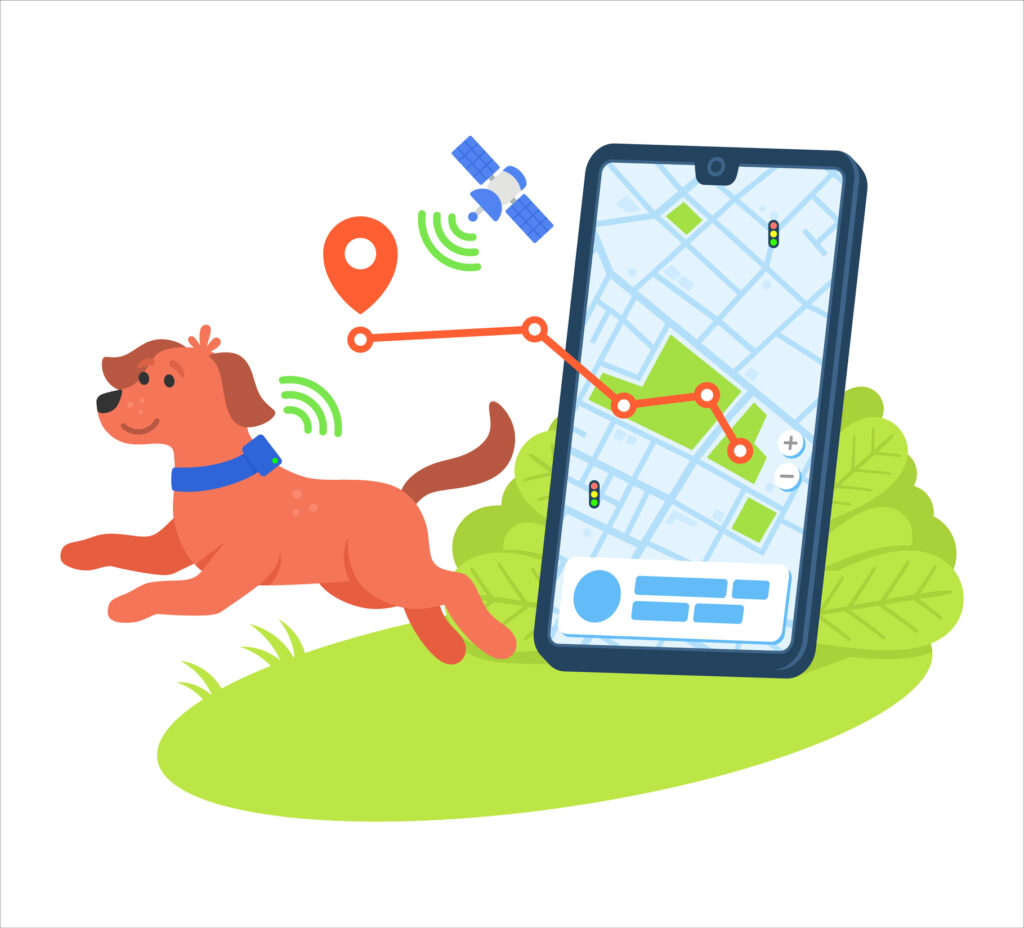GPS Tracking Devices for dogs
As a dog owner, ensuring the safety and well-being of your dog friend is a top priority. Registering your dog with a microchip is a legal requirement and a great way of proving ownership should your dog get lost or be stolen. A personalised collar and dog tag is also a great way to enable you are reunited quickly in the event of your dog going missing. Check out our blog about these identification methods by clicking here.
On the other hand a GPS tracking device is on another level and is an amazing advancement in technology in order to keep our dogs safe. These small but powerful devices are revolutionising the way we protect and monitor our beloved pets in the modern age.
In this comprehensive guide, we will explore the world of GPS tracking devices for dogs, how GPS tracking devices work, the various features available on some of these devices, the benefits of using them and we also take a look at some of the systems available in the marketplace today.
What is a GPS Tracking Device and how do they work?
GPS Global Positioning System tracking devices use advanced satellite technology to accurately determine the precise location of an object which in this case is our dog friend.
The calculated location information is transmitted to a server or the owners smartphone via cellular networks, Bluetooth or other wireless technologies.
The location information is usually displayed on a map allowing the owner to visualise their dog’s current position in real-time.
The GPS tracking device are usually lightweight, compact and designed to be easily attached to your dog’s collar or harness. They have real-time tracking capabilities that allow you to monitor your dog’s movements and receive updates directly to your smartphone or computer.
It is important to note that GPS tracking devices require a clear view of the sky to receive signals from satellites effectively. This means that dense urban spaces or heavy foliage like wooded areas may obstruct signals, this could result in reduced accuracy or temporary loss of tracking. Also most GPS tracking devices require a subscription plan or data service to transmit the location date to the owner’s device. Therefore, most units can’t be bought on a one off cost basis, they usually have a longer term subscription cost to factor in to your purchasing decision.
Features of GPS Tracking Device
GPS tracking devices for dogs often come with a range of extra features, here are some common extra features…
Geofencing
This allows you to set virtual boundaries on a map. When your dog enters or exits these predefined areas you will receive instant notifications on your smartphone. Geofencing helps ensure that your dog stays within safe zones and can be particularly useful for containing them in a specific area or alerting you if they wander off.
Activity Monitoring
Some GPS trackers provide activity monitoring features that track your dog’s movements, exercise levels and daily activity patterns. This information can help you ensure your dog gets enough physical activity and identify any changes in their activity levels which may indicate potential health issues.
Health and Wellness Tracking
Some advanced GPS trackers offer health and wellness tracking features. They can monitor parameters like rest patterns, sleep quality, calorie expenditure and even vital signs such as heart rate and body temperature. These features provide valuable insights into your dog’s overall well-being and can assist in early detection of health problems.
Two-Way Communication
A few GPS tracking devices include two-way communication capabilities, allowing you to interact with your dog remotely. You can send voice commands or soothing messages through the device, helping to calm your dog or guide them back to safety if they’re lost or disoriented.
Waterproof and Rugged Design
Many GPS trackers are designed to be waterproof and rugged. Making them capable of withstanding various outdoor conditions and activities. This ensures the device remains functional even if your dog enjoys water-based adventures or rough play.
Historical Location Data
GPS tracking devices often store historical location data, allowing you to review your dog’s previous routes, movement patterns and places they’ve visited. This information can be useful for tracking habits, identifying favourite spots or analysing behavioural changes.
Battery Life and Low Battery Alerts
Long battery life is crucial for uninterrupted tracking. GPS trackers may offer different battery-saving modes and provide low battery alerts, ensuring you have ample time to recharge or replace the device’s battery.
Multiple Users and Sharing
Some GPS trackers allow multiple users to access the device’s location data simultaneously. This feature is beneficial for households with multiple pet owners or when you want to grant access to a dog sitter or family member.
Subscription Required Tractive GPS Dog Tracker
| 4/5 | |
No Subscription Costs PitPat Dog GPS Tracker
| 3.5/5 | |
Subscription Required Tractive GPS Dog Tracker XL
| 4.5/5 |
The benefits of using a GPS Tracking Device on a dog
Using a GPS tracking device on your dog offers several benefits that contribute to their safety, well-being, and your peace of mind. Here are some key benefits of using a GPS tracking device for your dog:
Real-Time Location Monitoring
With a GPS tracker, you can monitor your dog’s location in real-time, allowing you to know exactly where they are at any given moment. This is particularly helpful if your dog tends to wander. You can quickly locate them and ensure their safety.
Lost Dog Recovery
If your dog goes missing or gets lost a GPS tracker significantly increases the chances of finding them quickly. You can track their movements in real-time, follow their route, and navigate directly to their location, reducing the time and stress involved in searching for a lost pet.
Peace of Mind
Knowing that you can track your dog’s whereabouts at all times provides immense peace of mind. Whether you’re at work, travelling or simply away from home, you can have confidence that your dog is safe and within the designated areas.
Safety in Unfamiliar Environments
When traveling or exploring new areas with your dog, a GPS tracker ensures their safety in unfamiliar environments. If they wander off or become disoriented, you can quickly locate them and prevent potential dangers.
Behaviour Monitoring
By analysing your dog’s movement patterns and habits recorded by the GPS tracker, you can gain insights into their behaviour. This can be especially useful for identifying any unusual or abnormal behaviour, helping you address potential health issues or anxiety triggers.
Improved Bonding and Training
With the ability to track and monitor your dog’s movements, you can actively participate in their training and behaviour modification. By understanding their habits, you can reinforce positive behaviours and address any areas that require improvement, strengthening the bond between you and your dog.
Community Assistance
Some GPS tracking devices have community features that allow users to report lost or found pets, creating a network of assistance. If your dog goes missing, other users in the area can help keep an eye out and notify you if they spot your dog.
Using a GPS tracking device on your dog offers invaluable benefits that contribute to their safety, well-being, and your peace of mind. It ensures you can quickly locate them if they wander off or get lost, provides insights into their behaviour and exercise levels, and allows you to actively participate in their training and overall care.
Other ways to keep your dog safe...
Collars and Tags
The most common and visible form of pet identification is a collar with an attached tag. The tag typically contains the pet’s name and the owner’s contact information. Collars and tags are relatively inexpensive, easy to obtain and both can be personalised with the owners contact details. However, they can be lost, removed or damaged therefore reducing their effectiveness as a long-term identification method.
The Control of Dogs Order 1992 means that all dogs in a public place must wear a collar and ID tag. You can be fined a whopping £5,000 if you do not comply. There are some exceptions to this rule for instance guide dogs for the blind and dogs used on official duties but on top of microchipping both collars and tags are a great starting point to protect your dog friend and increases the chance of being reunited quickly.
Best Seller | Personalised Engraved Dog Tag Available in 2 sizes 32 & 36mm Pet ID Tags Glitter paw print in various colours including split ring. Personalise with contrasting bold text making the details stand out. |
Highly Rated | Solid Brass Personalised Dog Tag Laser engraved ID tag available in different shapes and sizes. Available in bone shaped, heart shaped, round shaped and star shaped. Order in different sizes for different sized dogs. |
latest articles
Lorem ipsum dolor sit amet, consectetur adipiscing elit. Ut elit tellus, luctus nec ullamcorper mattis, pulvinar dapibus leo.









